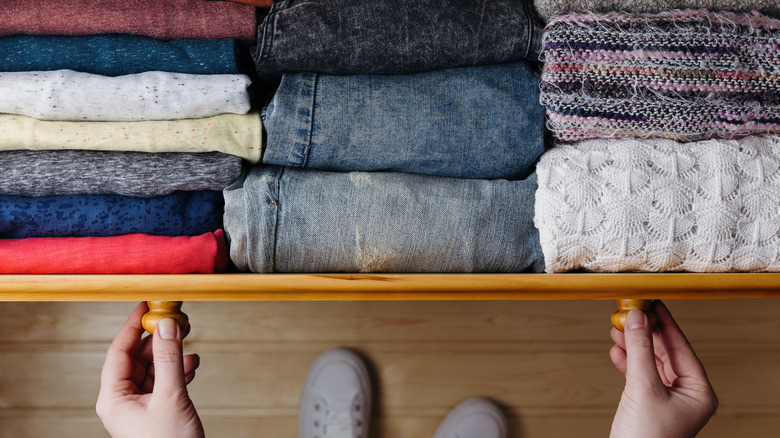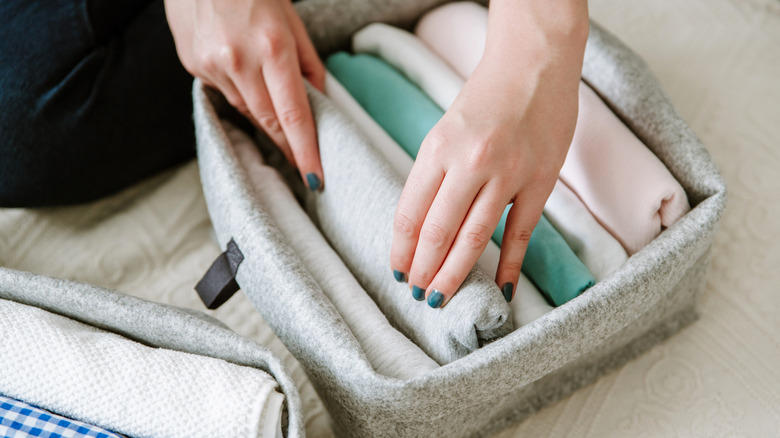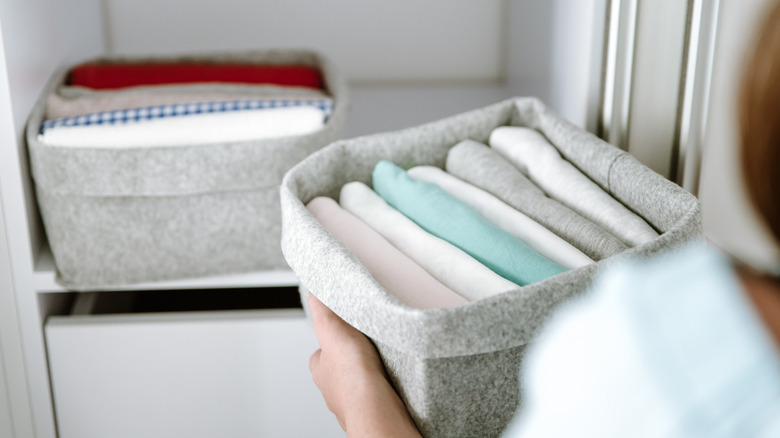What Is File Folding And Why You Should Use It To Get More Organized
When it comes to organizing your closet, there's an array of ways you can arrange your things so they make sense in the space. As Closets by Design points out, hanging is one of the most effective methods as it helps to keep any articles, particularly if they're delicate, from wrinkling. Perhaps, though, your closet is short on hanging space, and you're forced to rely on folding to store your stuff. Unfortunately, it's a reality for many of us, especially if the closet is being shared.
If you're cramming your things into dressers or drawers, how often do you waste time looking for something that was ultimately found crumpled at the bottom? Or you've had to disturb piles on a shelf for that one item, also at the bottom, leaving your closet a cluttered mess? Even if you take pride in your neat folding skills, stacking tops, shorts, or pants horizontally, either in a drawer or on a shelf, will still cause unnecessary stress on your daily routine — not to mention a perpetually disorganized bedroom!
Fortunately, there is an easier, better, and even faster way to fold your clothes, and that is by using the technique of file folding. Ahead, you'll find out exactly what it is and why you should use it to get more organized.
What is file folding and how to do it
File folding is a unique way to organize your clothes, made popular by Marie Kondo of KonMari. It essentially gets the name from the way your clothing looks once it's been folded and placed in a drawer or basket. In other words, it resembles file folders lined up neatly in a filing cabinet.
As Abby Organizes explains, file folding aims to have the item fold down to a small size so that you can fit more stuff in less space. You can use file folding for almost anything casual, including t-shirts, sweaters, sweatshirts, leggings, shorts, jeans, and pajamas.
The equally exciting element of filing your clothes is that it's not all that different from how you are likely already folding your clothes. A shirt, for example, can be folded with the sleeves tucked in and then in half horizontally. To get it to stand upright, you'll want to fold it again at least once more to give it some weight.
According to The Container Store, it really depends on the length of the shirt and the height of what it's ultimately being stored in. Once all of your clothes have been file folded, simply place as many as you can fit comfortably into the drawer or a basket in the standing position. Be sure to leave some wiggle room, so they're not difficult to take in or out.
How file folding keeps you more organized
If there is one new practice you should implement into your tidying routine, it is file folding. It's simple, effective, and easy to maintain, especially once you develop the habit. As Life in Jeneral explains, the more effortless you can make a chore like doing laundry, the less agonizing it will be overall.
Placing items vertically allows you to see what you have there at all times. This eliminates the need to cause chaos within the dresser or on a shelf while searching for a particular item. The visual clutter, especially on shelving, will be eliminated. Even if you choose clear bins to place clothes in, they will look infinitely neater when you open your closet door.
Speaking of bins, you can use them to separate types of clothing to keep your things more organized. For example, Container Stories mentions that she uses fabric baskets to sort denim from light to dark. You can also retain one basket for skinny jeans, one for bootcut, and so on. Place a label on the basket or the shelf itself to keep things in their place and know exactly where to return them once the laundry is done.
Lastly, file folding saves space which is extremely helpful if you're faced with a small closet. Of course, this doesn't give you free way to buy or keep more than you need, but it does alleviate the stress of not having enough room for the things you love.


